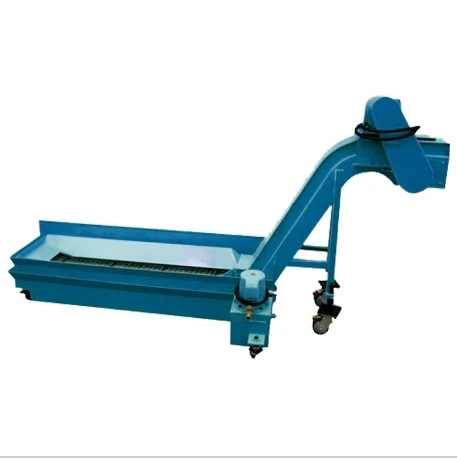chip conveyor
Understanding Chip Conveyor Systems in Modern Manufacturing
In today's fast-paced manufacturing landscape, efficiency and productivity are paramount. One of the key components that contribute to streamlined operations in various industries, particularly in machining and metal working, is the chip conveyor. These specialized conveyor systems play a critical role in removing metal chips, debris, and scrap materials produced during manufacturing processes, thereby ensuring a cleaner and safer working environment.
A chip conveyor is designed specifically to transport chips generated from machining operations, such as milling, turning, or grinding. The production of these chips can vary significantly, depending on the materials being processed and the type of machining operation used. Without an efficient means of removal, these chips can accumulate and disrupt operations, leading to potential downtime and increased labor costs. This is where chip conveyors become indispensable.
There are several types of chip conveyor systems available, each tailored to meet specific needs based on the type of chips being handled and the layout of the manufacturing facility. The most common types include
1. Magnetic Chip Conveyors These conveyors are particularly effective for ferrous materials. They utilize a magnetic field to lift and transport metal chips along a conveyor track. Magnetic chip conveyors are renowned for their ability to handle small and fine chips, preventing clogging and ensuring a steady flow of material.
2. Sliding Bed Chip Conveyors These conveyors consist of a trough where chips slide down an inclined surface to be collected at the end. They are relatively simple in design and suitable for lighter-duty applications. Their straightforward construction makes them easy to maintain and cost-effective.
3. Auger Chip Conveyors Also known as screw conveyors, auger conveyors utilize a rotating screw mechanism to transport chips. This type is effective for moving chips over longer distances or into bins for recycling or disposal. Their versatility allows them to handle a variety of materials, including larger chip sizes.
chip conveyor

4. Floor-mounted Chip Conveyors These are installed at the floor level and are designed to transport chips away from multiple machines simultaneously. This multi-functional capability makes them ideal for larger manufacturing setups with several machining centers.
The selection of a chip conveyor system hinges on various factors, including the volume of chips generated, the types of materials being processed, and the overall layout of the manufacturing area. Additionally, considerations such as maintenance requirements, operational costs, and ease of integration with existing machinery are crucial.
One of the most significant advantages of implementing a chip conveyor system is the reduction of labor costs. By automating the chip removal process, manufacturers can minimize the need for manual labor. This not only saves time but also reduces the risk of injuries associated with handling sharp and heavy metal chips.
Moreover, chip conveyors enhance overall shop cleanliness and safety. By continuously removing chips from the work area, they help maintain a tidy and safer environment for machine operators. This can lead to increased morale and productivity, as workers can focus on their tasks without the distraction of cluttered workspaces.
Furthermore, chip conveyors can contribute to sustainability efforts within the manufacturing industry. By efficiently collecting and transporting metal chips, manufacturers can facilitate recycling initiatives. Recycled materials can significantly reduce the costs associated with raw material procurement and contribute to a more sustainable production process.
In conclusion, chip conveyor systems are an essential element of modern manufacturing. They not only promote operational efficiency and workplace safety but also support sustainability initiatives. As industries continue to evolve and embrace automation, the role of chip conveyors will undoubtedly become more critical, pushing manufacturers toward enhanced productivity and environmental responsibility. Investing in the right chip conveyor system is not just about managing waste; it is a strategic move toward optimizing the entire manufacturing process.








